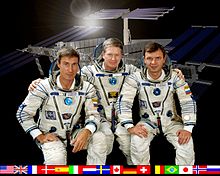
Back البعثة 1 Arabic Expedició 1 Catalan Expedice 1 Czech ISS Ekspedition 1 Danish ISS-Expedition 1 German Expedición 1 Spanish 1. ekspeditsioon Estonian Retkikunta 1 Finnish Expédition 1 (ISS) French Expedición 1 Galician
 The ISS during Expedition 1, seen during the approach of STS-97, the first Shuttle mission to visit the inhabited space station | |
| Mission type | ISS Expedition |
|---|---|
| Mission duration | 137 days 16 hours 9 minutes (hatch open to hatch close)[1][2] 140 days 23 hours 38 minutes (launch to landing)[3][4] |
| Expedition | |
| Space station | International Space Station |
| Began | 2 November 2000, 09:23:00[3] |
| Ended | 19 March 2001, 04:32:00[4] |
| Arrived aboard | Soyuz TM-31[5][6] |
| Departed aboard | STS-102[NASA 1] Space Shuttle Discovery |
| Crew | |
| Crew size | 3 |
| Members | William Shepherd Yuri Gidzenko Sergei K. Krikalev |
 Expedition 1 mission patch  L-R: Sergei K. Krikalev (Russia), William M. (Bill) Shepherd (United States), and Yuri Pavlovich Gidzenko (Russia) | |
Expedition 1 was the first long-duration stay on the International Space Station (ISS). The three-person crew stayed aboard the station for 136 days, from November 2000 to March 2001. It was the beginning of an uninterrupted human presence on the station which continues as of 2024. Expedition 2, which also had three crew members, immediately followed Expedition 1.
The official start of the expedition occurred when the crew docked to the station on 2 November 2000, aboard the Russian spacecraft Soyuz TM-31, which had launched on 31 October 2000 at the Baikonur Cosmodrome in Kazakhstan.[7][8] During their mission, the Expedition 1 crew activated various systems on board the station, unpacked equipment that had been delivered, and hosted three visiting Space Shuttle crews and two uncrewed Russian Progress resupply vehicles. The crew was very busy throughout the mission,[9] which was declared a success.
The three visiting Space Shuttles brought equipment, supplies, and key components of the space station. The first of these, STS-97, docked in early December 2000, and brought the first pair of large U.S. photovoltaic arrays, which increased the station's power capabilities fivefold.[NASA 2] The second visiting shuttle mission was STS-98, which was docked in mid-February 2001 and delivered the US$1.4 billion research module Destiny, which increased the mass of the station beyond that of Mir for the first time.[NASA 3] Mid-March 2001 saw the final shuttle visit of the expedition, STS-102, whose main purpose was to exchange the Expedition 1 crew with the next three-person long-duration crew, Expedition 2.[NASA 4] The expedition ended when Discovery undocked from the station on 18 March 2001.
The Expedition 1 crew consisted of an American commander and two Russians. The commander, Bill Shepherd, had been in space three times before, all on shuttle missions which lasted at most a week. The Russians, Yuri Gidzenko and Sergei K. Krikalev, both had previous long-duration spaceflights on Mir, with Krikalev having spent over a full year in space.[NASA 5][NASA 6][10]
- ^ "NASA - International Space Station Status Report #00-43". Archived from the original on 4 May 2021. Retrieved 3 May 2022.
- ^ "NASA - STS-102 Mission Control Center Status Report # 27". Archived from the original on 4 May 2021. Retrieved 3 May 2022.
- ^ a b "NASA - International Space Station Status Report #00-48". Archived from the original on 1 June 2017. Retrieved 3 May 2022.
- ^ a b "NASA - STS-102 Mission Control Center Status Report # 23". Archived from the original on 1 June 2017. Retrieved 3 May 2022.
- ^ "EXPEDITION ONE (ISS-1) – CREWS OF THE FIRST LONG-DURATION EXPRDITION". Energia. Archived from the original on 26 May 2010. Retrieved 11 August 2010.
- ^ "Energia Press Release on the Soyuz TM-31 (Expedition 1) Launch". SpaceRef.com. 31 October 2000. Retrieved 11 August 2010.[permanent dead link]
- ^ "First crew starts living and working on the International Space Station". European Space Agency. 31 October 2000. Archived from the original on 17 December 2018. Retrieved 24 January 2021.
- ^ Todd Halvorson. "Space Station Is Opened For Business As Expedition One Crew Floats Aboard". Space.com. Archived from the original on 19 December 2009. Retrieved 7 August 2010.
- ^ Todd Halvorson (24 January 2001). "ISS Crew Works Feverishly; Shepherd OK with Tourist Tito". Space.com. Archived from the original on 24 May 2009. Retrieved 8 August 2010.
- ^ Cite error: The named reference
TIME-Nov2was invoked but never defined (see the help page).
Cite error: There are <ref group=NASA> tags on this page, but the references will not show without a {{reflist|group=NASA}} template (see the help page).
© MMXXIII Rich X Search. We shall prevail. All rights reserved. Rich X Search